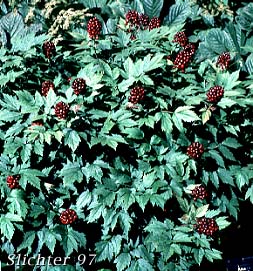 The photo at right shows baneberry with its bright reddish-black fruits from the
Royal Botanical Gardens in Edinburgh, Scotland....July 18, 1989.
The photo at right shows baneberry with its bright reddish-black fruits from the
Royal Botanical Gardens in Edinburgh, Scotland....July 18, 1989.
Baneberry is an attractive wildflower with one to several erect and branched stems arising 40-100 cm high from a cluster of lower leaves. All the large leaves are found on the stem. Individual leaves are twice to thrice pinnatifid, the leaflets ovate in shape tapering to a point, and the the margins of the leaflets having coarse teeth or lobes. Individual leaflets measure from 3-9 cm long.
The inflorescence consists of axillary or terminal clusters of many small white flowers. The 3-5 sepals are white or purplish-tinged and measure about 2-3 mm long. The 5-10 white petals are narrow and are roughly about the same size as the sepals. The stamens are longer than the petals. The fruit are red or white in color and are spherical to ellipsoid in shape, measuring from 5-11 mm long.
As noted in the photo above, baneberry is an attractive plant for the natural border in the garden. The lacy leaves and the vibrant red or white fruit are both reasons to use this wildflower in the garden, although one should remember that the fruits are deadly poisonous.
Baneberry may be found in moist, dark woods and along streambanks, primarily west of the Cascades, but also eastward in moist, mountainous areas.
Baneberry may be found from Alaska south to California and east to the Rockies, and found again along the Atlantic coast.
In the Columbia River Gorge it may be found between the elevations of 100'-4400' from east of Troutdale, OR east to near the Major Creek Plateau.